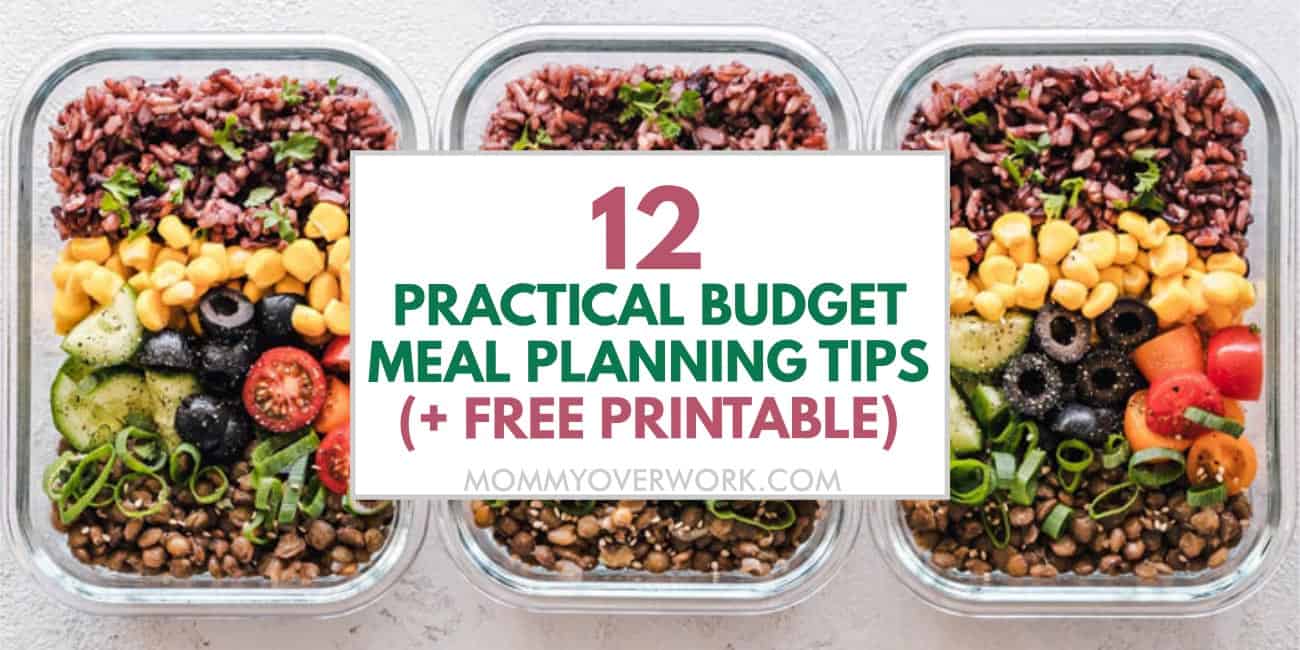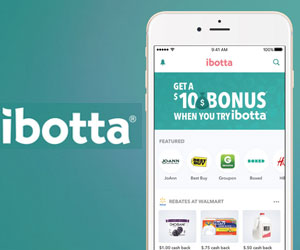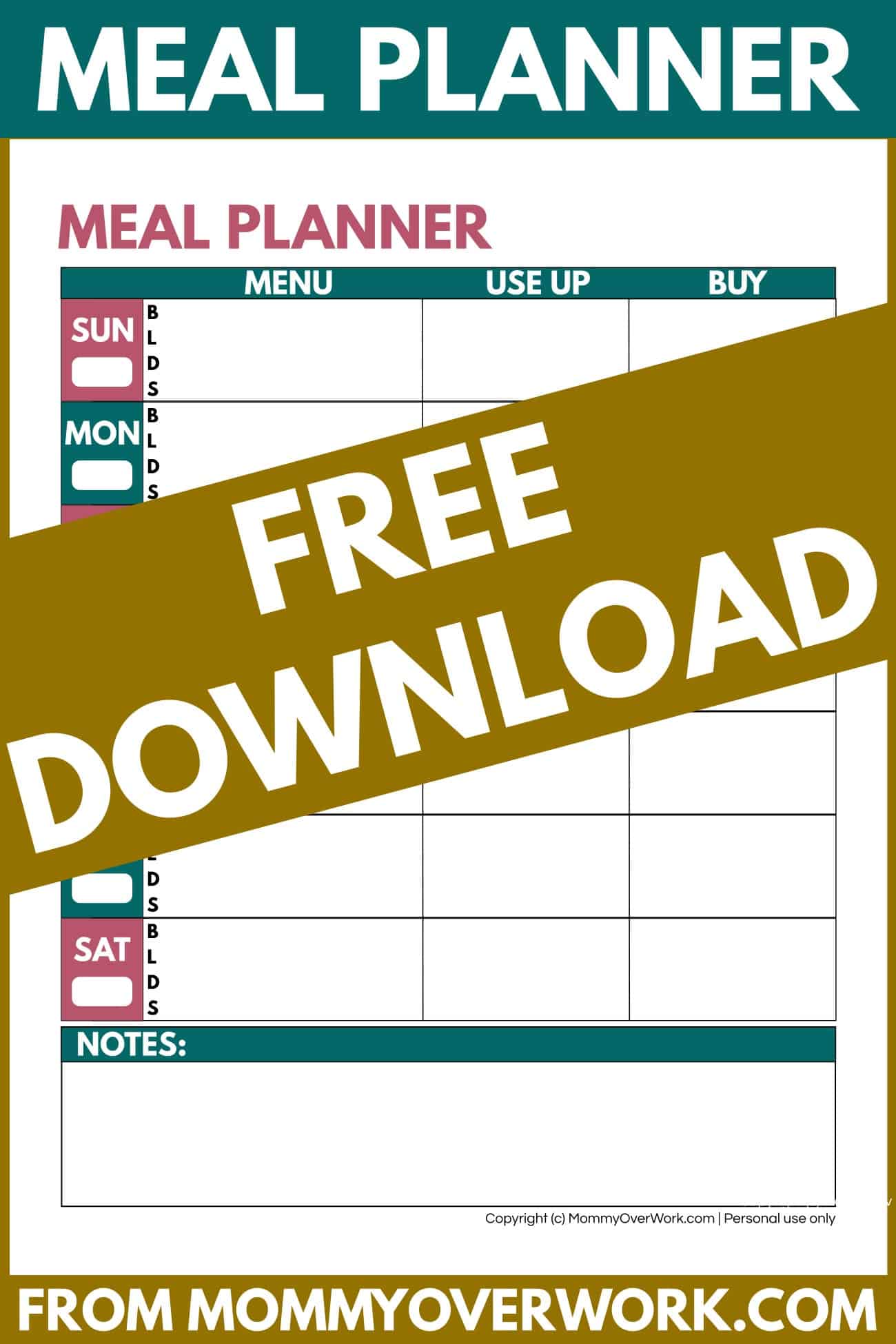People say time is money. They should say food is money too, because we all spend a lot of dough on our food costs.
That’s why it pays to have good budget meal planning skills under your belt, so you keep more of that dough in your pockets (and your pantry).
In this post:
- Learn tons of tips on how to do meal planning on a budget
- Grab our free budget meal planner printable
- Get step-by-step instructions on how to create a cheap meal plan

Disclosure: Opinions expressed are our own. If you buy something through any of our affiliate links on this page, we may earn a commission at no extra cost to you. Thanks for supporting our site.
Take action
- Snag our simplified meal planning template at the end of this post
- Take stock of what you have to start off your meal plan
- Shop for the rest of your ingredients using the Ibotta app for extra savings*
Tips for budget meal planning
Here are some guiding principles you’ll want to follow to make sure that your meal plan is actually economical:
The fewer ingredients, the cheaper the meal
Remember that the more ingredients your meal requires, the more expensive it will probably end up being.
Setting a limit of 2-3 ingredients other than the starch and seasonings will help keep the meal low-cost (and easy to make!).
Use specialty ingredients for… special occasions
Specialty ingredients are more expensive, and it’s more likely to go bad because it’ll be hard for you to use it up.
By saving meals that require specialty ingredients for fancy occasions, it’ll make those moments extra special.
Go veggie as much as you can
Vegetarian meals are known for being great on your waistline, but they can help you bulk up your wallet too. Beans and grains are incredibly cheap, so try to plan as many meals as you can that feature those items heavily instead of meat.
There are a lot more vegetarian protein sources than you think.
For example, pair this simple recipe for fried tofu with chives with quinoa and get two sources of protein in the same dish for a very low cost.
Choose produce that’s in season
Figuring out what produce is in season now and going for those means you’ll get fruits and veggies that are both tastier and easier on your wallet. Double bonus!
Consider skipping the grocery shopping altogether
The best grocery bill is $0, which you can achieve by trying a pantry purge challenge. This is when you make all your meals using only what you already have at home, meaning you don’t have to spend a dime on groceries for the week.
Learn the right way to purge your pantry, and grab our free kitchen inventory sheet to help you take stock of the ingredients you already have in your pantry, fridge, and freezer while you’re at it.
Take shelf life into consideration
One way to reduce food waste, which reduces money waste, is to pick up staples that can last a while, like canned beans or frozen vegetables.
That way, you don’t have to scramble to use something right away before it’s no good anymore.
Use a single ingredient in multiple ways
If you can use a single ingredient in a variety of ways, that means you can buy it in bulk to save even more.
For example, this Tex-Mex black bean mix is easy to make, but can be used in nachos, tacos, burritos, Mexican bowls, taco salad, and more!
Make cheap staples a regular part of your diet
Dried beans, lentils, and oats are super dirt cheap ingredients, so if you eat them all the time, that means you’ll be saving money on the regular. (They’ll also help you to be regular, if you know what we mean).
Aim for smaller portions
The concept is simple: less food = less money spent. Americans eat a lot more than they actually need, simply because of the way we serve food.
Figuring out how to control your portions is literally the easiest way to eat cheaper because it requires so little effort.
Ring up extra savings with a grocery savings app
Remember the slogan "there’s an app for that"? Well, there are definitely apps for saving money on your groceries! These kinds of apps offer tons of rebates, coupons, and cashback opportunities each time you take a trip to the grocery store.
Our absolute favorite app is Ibotta*, which you can get a cash bonus for if you create an account as a first-time user.

Be strategic about where you buy from and how you shop
Saving on food isn’t only about what you eat. Where you buy from and how you do your shop matters a whole lot too.
Find out how to save money on your grocery shopping bill by doing your homework before hitting the store, and what pitfalls to avoid while you’re roaming the aisles.
Budget meals planner [free printable]
The master plan behind all of your grocery shopping should be your carefully-crafted budget meal plan. That’s why we created a meal planner template that’s specifically designed to help you save money.
Below the preview image are a simple set of instructions to come up with a cheap meal plan for the week.

- Step 1. Check what food you have in your fridge, freezer, and/or pantry that you want to use up this week
- Step 2. Build your meals and snacks for the week around those ingredients
- Step 3. Fill in the “Use up” column with the ingredients you already have
- Step 4. Do your best to keep the “Buy” column as sparse as possible
- Step 5. Add any pertinent notes (ex: sales, pricing, total spent on groceries, family feedback, and number of portions you were able to create)
- Step 6. Keep a binder or take a picture of these meal plans + accompanying grocery receipts on your phone so you improve your spending or can refer back to ideas that worked well for your family
You can download this worksheet template for free without any sign-up required. Please help us share our resource so other can enjoy it too!
Grab This Freebie:
[Personal use only. To help us continue to offer this free resource to others, please share this post (not the direct file) before clicking to the freebie. Thank you!]
Share This: Save Pin | FB Share
Get Free Printable: Get the File
Conclusion
Incorporate cheap meal plans into your financial diet to save big. Reduce your food costs by using a budget meal planner. meal planning on a budget doesn’t have to be hard, if you have our tips and free meal planning printables to help you out.
Continue Reading: Save & Make Money posts →


Leave a Reply